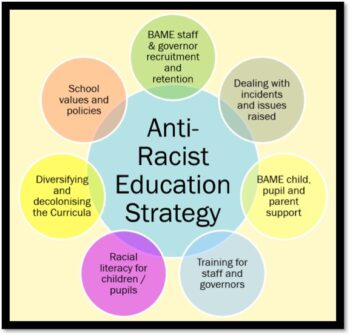
07/03/2022
In March 2022 a small number of staff who are involved with the Praxis Project, attended a training workshop on ‘Racial Literacy for Educators’. We organised this because of our ongoing discussions within our meetings, about experiences of racism . The workshop was ably facilitated by experienced trainer Ms. Abha Aggarwal of Race Matters (See: www.racematters.education). This blog is not so much an account of this three-hour workshop. To do so in a short blog would not do it justice. Ms. Aggarwal’s presentation spanned two centuries of the history of racism, it covered a vast array of literature and resources and it provided us with a wealth of experience, knowledge and reflection on how we might think about anti-racist frameworks in our work in a third level institution.
The training session aimed to equip us to engage in the sensitive and complex issues of ‘race’ and racism by:
- exploring ‘race’ and racism in the historical and contemporary context including an outline of structural/institutional racism, bias and privilege;
- giving an understanding of the experiences of young people, both in terms of how they learn ‘race’ and their racialised experiences;
- outlining the key areas that education settings can examine to advance their anti-racist practice.
These are just a few reflections from some of us who attended the online training.
Gertrude’s reflections
A few things linger in my mind. Firstly, I was conscious of the fact that I was the only white person at the training session. While I knew the participants, I couldn’t help but feel a certain kind of responsibility for ‘whiteness’. I didn’t feel I ‘represented white people’ but I had a sense of how it could be if you are seen as the only ‘other’ in the room, especially if you are in a less powerful position than I was in this room as the co-organiser of the event. The training was excellent, but I was hurt by a comment made by the facilitator after one comment I made about not wanting to ‘say the wrong thing’, either here or anywhere else. One participant, who knows me a long time said that I had an excellent sense of positioning, but the facilitator said, ‘you people, it always comes back to how you are feeling’. I did think it was an unfair comment, but I also think it is incumbent upon us all to listen deeply. ‘You people’ is not helpful in any circumstance. Nobody represents ‘you people’. However, we are all coming from a different place and in this context, I am coming from a position of white privilege and do not know what it is like to experience the world in other shoes. Therefore, when we feel this sensitivity or even hurt, we do need to reflect on why someone would say this. ‘You people’ does not help but neither does ‘I’m hurt’. We need to get over that hurt and try to unpack, unlearn and reflect on our experience of white privilege. Many people over the years have said to me in response to what felt like unfair accusations ‘but I didn’t mean it the way she or he picked it up’. Yes, but we haven’t walked in that person’s shoes. We need to sit back, reflect and think about how if you go about the world experiencing discrimination based on the colour of your skin, all your life, you might see things differently.
It was helpful therefore that there was further conversation on the strong emotions which can come with discussions on racism. It is important to allow the reality in and acknowledging that it is tricky. In Ireland, particularly in my generation and those that came before, we were socialised to consider White as a neutral background against which race exists. I grew up in a very homogenous society. But ‘white’ is also a colour and carries meaning. It is not about people being ‘good’ or ‘bad’, it is more about understanding that the idea of ‘race’ itself is a social construct. The reality is we all live in societies which give us racial identities.
The historian in me always likes to understand the historical context. We were presented with various maps, always helpful in a pedagogical context. One showing a map of human migration over time, highlighting that we are one human race and are an incredibly homogenous people. Another was a skin colour map, which show that what people have termed as ‘race’ is only about the amount of sunshine we get as humans, the amount of UV rays. Hence another map showing where the idea of race came from and a history trip from the first European colonisation in the Americas to the colonisation of Africa by Europe, the carving up of Africa post World War 1, by European powers. A history lesson on how the idea of ‘race’ was used to justify killing and extraction of resources. History is a vital part of our Development Education journey and development as global citizens.
Coming on to more recent times, the presenter talked about critical race theory. The traditional perspective might see racism as an exceptional occurrence whereas the critical perspective racism is operating extensively, it is normalised and taken for granted. In the traditional perspective people who are enacting racism are doing so willingly and knowingly, in the critical perspective racism can be enacted through biases, stereotypes, ‘colourblind’ policies and rhetoric. In the traditional perspective people enacting racism do so out of racial hatred / racial superiority, whereas in the critical perspective people or systems can create discriminatory impacts despite genuine intentions of fairness.
We also critically analysed images from mostly UK media. One example was the Grenville fire in London where a tower block in Kensington went on fire killing many people. The facilitator discussed how the ignoring of earlier complaints, the nature of the cladding material in the building, etc shows how ‘race’ did play a role in decisions, there were investigations but no one was arrested and held accountable. One comment made that struck me, was that ‘racism is harming human beings’.
We talked then about the Pyramid of Oppression, where you have overt white supremacy at the tip of the iceberg, with all the visible signs of racism above ‘sea level’ e.g. racial slurs, racial jokes, right up to burning crosses, swastikas and lynching. Below the sea we find covert white supremacy which is often socially acceptable, such things as hiring discrimination, racial profiling, euro centric curriculum, fearing people of colour, colorblindness and not challenging racist jokes. When someone says ‘it is just a joke’ they are complicit in enacting racism. She used the analogy of a gold fish swimming in one direction but lots of other fish swimming the other way. If we are swimming with the current, it is hard to have visibility and to swim against the current, therefore racism becomes embedded and even hard to uproot. We then discussed structural and institutional racism.
We then went on to discuss how we as human beings/as children, take on these ideas. The facilitator showed a clip of a video where children play with dolls. In the 1940s, psychologists Kenneth and Mamie Clark designed and conducted a series of experiments known colloquially as “the doll tests” to study the psychological effects of segregation on African-American children. Drs. Clark used four dolls, identical except for color, to test children’s racial perceptions.
Here’s a modern day version of the original experiment with Italian children: https://youtu.be/qStk4vrHKRQ
It shows how black and brown children have internalised ideas of themselves. The majority of children in all of these experiments over the years have chosen the white doll as their favourite, often stating things like ‘I like it because it is white’ or ‘because it has blue eyes’. They mostly chose the black doll as the ‘naughty doll’ The look on childrens’ faces when asked are asked ‘which doll looks like you?’ is upsetting. You can see the crestfallen look on their faces and the realisation that the doll that looks like them, is the one that they chose as naughty.
I have never felt comfortable with this experiment since I think it hurts the children at the centre, but it does show how we all internalise what society is telling us about the colour of our skin. The facilitator pointed out something I found interesting. A big difference between black and white experiences is that in conversations with parents etc, black children begin to understand that ‘race’ does have meaning and that it can be negative. For white children whose families have not had lived experiences of racism and oppression, that understanding of the significance of colour is not understood.
Finally we touched on what this means for an educator and for educational institutions. There are so many areas where we cannot become complacent. We need to not just ‘have’ anti-racist policy but actually understand and implement them; we need to look at curriculum, teaching methodologies, general approaches to pedagogy, research and projects. We need to look at increased representation of a diverse society within all aspects of college life and ask if all staff and students should attend anti-racism education?
In conclusion, the facilitator made the following points:
Race/Racism is complex, nuanced and constantly shifting and deeply embedded;
- Silence is not neutral – get comfortable with the uncomfortable topic of race and racism. No one is unaffected.
- Let go of the good/bad binary – we ALL take on multiple, complex, unhelpful messages about racial groups.
- We need to understand individual prejudice and systematic issues.
- We need to focus on ‘impact’ rather than intent.
- We need to seek our a range of voices, and have input of people of colour.
This was most definitely a comprehensive and challenging workshop and we hope that we as UCC staff can bring some of the ideas presented here forward into not just our own work but also to bear on our wider context at University College Cork.
Dr Gertrude Cotter
